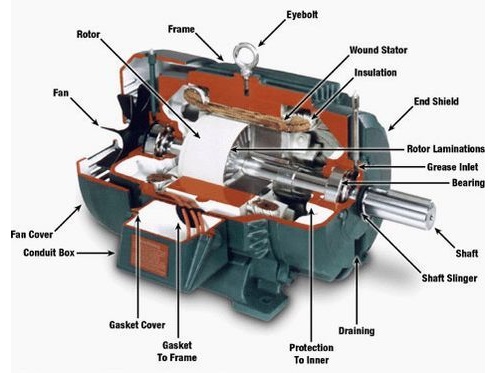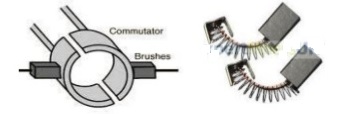DC motor runs on direct or dc current. On this page we shall understand the function of each component of the motor. In general there are two major parts of any motor i.e. stationary part and moving part. The stationary part is mainly the outer part that houses the field windings and receives the supply also famous as stator.
On the other hand the rotating part also famous as rotor is the motor component that gives the output of the motor function i.e. the mechanical or rotational movement.
If we go in further detail there are several other components that are subsidiary to above two major motor components. These additional dc motor components include yoke, poles, field winding, armature winding, commutator and brushes.
In the following section now we shall see all these parts in further detail.
Parts of DC Motor
Motor Yoke
The yoke of a dc motor forms an integral part of the stator or the static part of the motor. It is made up of cast iron or steel. Its main function is to form a protective covering over the inner sophisticated parts of the motor and provide support to the armature.It is outer cover of dc motor also called as frame.
Yoke also ensures protection to the rotating and other part of the motor from moisture, dust and other weathering affects. Motor yoke is an iron body which provides the path for the flux to complete the magnetic circuit as well. It provides the mechanical support for the poles. Yoke is made of low reluctance material such as cast iron, silicon steel, rolled steel, cast steel etc.
Poles of DC Motor
The poles inside the motor are actually electromagnets and the field winding is wound over it. Poles produce the magnetic flux when the field winding is excited. The magnetic poles of DC motor are fitted onto the inner wall of the yoke.
The construction of pole is done using the lamination of particular shape to reduce the power loss due to eddy current. The construction of magnetic poles comprises of two parts namely, the pole core and the pole shoe stacked together under hydraulic pressure and then attached to the yoke. Pole shoe is an extended part of a pole. Due to its typical shape, it enlarges the area of the pole, so that more flux can pass through the air gap to armature.
These two structures are assigned for different purposes, the pole core is of small cross sectional area and its function is to just hold the pole shoe over the yoke, whereas the pole shoe having a relatively larger cross-sectional area spreads the flux. Poles are manufactured using low reluctance magnetic material such as cast steel or cast iron.

Field Winding of DC Motors
The field winding of DC motor are made with field coils (copper wire) which are wrapped over the slots of the pole shoes. The winding or wrapping of wires is done in such a manner that when field current flows through it opposite polarity produces in adjacent poles. The field winding basically form an electromagnet, that produces field flux within which the rotor armature of the DC motor rotates, and results in the effective flux cutting.
The coil wound on the pole core are called field coils. Field coils are connected in series to form field winding. Current is passed through the field winding in a specific direction, to magnetize the poles and pole shoes. Thus magnetic flux is produce in the air gap between the pole shoe and armature.
Field winding is also called as exciting winding. Material Used for copper conductor is copper. Due to the current flowing through the field winding alternate N and S poles are produced.
Armature core
Armature core is a cylindrical drum mounted on the shaft. It is provided with large number of slots all over its periphery and it is parallel to the shaft axis. Armature conductors are placed in these slots. Armature core provides low reluctance path to the flux produced by the field winding. Armature core is made of of high permeability, low reluctance cast steel or cast iron material. In order to minimize eddy current losses laminated iron core is used.
Armature Winding of DC Motors
Armature conductor is placed in a armature slots present on the periphery of armature core. Armature conductor are interconnected to form the armature winding. When the armature winding is rotated using a prime mover, it cuts the magnetic flux lines and voltage gets induced in it. Armature winding is connected to the external circuit (load) through the commutator and brushes.
The armature winding of DC motor is attached to the rotor, and as a result is subjected to altering magnetic field in the path of its rotation which directly results in magnetic losses. For this reason the rotor is made of armature core, that’s made with several low-hysteresis silicon steel lamination, to reduce the magnetic losses like hysteresis and eddy current loss respectively. Since the armature winding carries entire load current hence it is made up of pure conducting material i.e. copper.
Construction of armature winding of DC motor can be of two types i.e. lap winding and wave winding. In the lap winding the number of parallel paths between conductors A is equal to the number of poles P. i.e A = P. On the other hand in wave winding the number of parallel paths between conductors A is always equal to 2 irrespective of the number of poles.

DC Motor Commutator
Commutator is a cylindrical drum mounted on the shaft along with the armature core. It converts the AC emf generated internally into DC, hence helping to produce unidirectional torque. It is made up of large number of wedge shaped copper segments which are stacked together. Also the segments are insulated from each other by thin layer of mica.
Armature winding are tapped at various points and these tapping are successively connected to various segments of the commutator. In the case of DC motor commuter is responsible to commute or relay the supply current from the mains to the armature winding housed over a rotating structure through the brushes of DC motor.
Function of DC Motor Brushes
Current are conducted from the armature to the external load by the carbon brushes which are held against the surface of the commutator by springs. Basic function of brushes is to collect the current from the commutator and apply it to the external load in generator, and vice versa in motor.
So, the commutator and brush unit of the DC motor is concerned with transmitting the power from the static electrical circuit to the mechanically rotating region or the rotor. Brushes are made of carbon or graphite structures, making sliding contact over the rotating commutator. Brushes are rectangular in shape.
Discover more from Electrical Engineering 123
Subscribe to get the latest posts sent to your email.

